Australia So Much to See


The sandy Northern Territory side of the Great Central Road had been recently graded and we made very good time. The corrugations
are never graded right out and soon return with the traffic on the road. The Petermann Ranges came into view, and the drive
was lovely.
Central Australia 2008. We leave the Northern Territory via the Great Central Road, and continue into Western Australia, featuring
a visit to the Giles weather station and Len Beadell displays.
Scenery was constantly changing, with areas of spinifex, mulga, mallee and desert oaks and low ranges all around and different shades
of sand.
Our good run on this wide road continued, with only a few other vehicles sharing it with us. Here small corrugations remain
on the graded road where fresh grader tracks can be seen. After a couple of weeks the corrugations will have returned.
Camels are in abundance, from large family groups with young calves to solitary bulls. Even in daylight hours, driving with
caution is needed as they can step out right in front of traffic giving little warning for braking, and may stay there blocking the
road for some time, or amble along the road ahead of the car.
The Great Central Road links the Northern Territory from the Uluru-Kata Tjuta National Park to Laverton in the Western Australian
Goldfields. Permits are required to travel both the Northern Territory and the Western Australian sections.
Groves of desert oaks looked lovely against the background of the colourful Petermann Ranges. Young desert oaks look soft
and fluffy before developing expanded branches
The camp ground near Kaltukatjara settlement at Docker River is in a grove of desert oaks with hills of the Petermann Range surrounding
it, and the local community has set up honesty box camping with flush toilets and cold showers in tin sheds at each camp. However
it has a history of vandalism. When we arrived we found the water supply no longer worked and the honesty box was smashed. Having made such good time on the graded road, we had no need to stop at this otherwise pleasant location.
The drive into Western Australia and beyond for some time was through a series of ranges and the country was picturesque.
Here we passed the first Len Beadell plaque of the drive. He marked this tree with a plaque that reads:
Remains of the first Blue Streak rocket launched from Woomera Rocket Range on 5th June 1964, was found fifty kilometres south
east of Giles in 1980.
This survey peg was placed at the Giles Weather Station by Len Beadell 9th May 1956.
The Len Beadell team (who called themselves the Gunbarrel Construction Co) grader is on display together with three original Len Beadell
marker plaques. Plaques in the field have been replaced with replicas to preserve the originals. The map on the signage
shows the areas where Beadell's team formed roads.
Surveyor Len Beadell, also a wonderful cartoonist, drew this cartoon which is on display in the visitor room at the Giles Weather
Station.

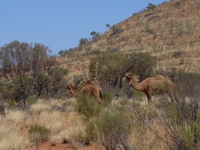
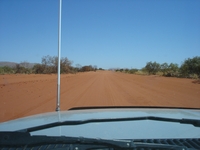
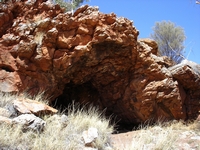
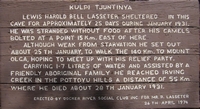
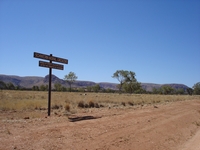
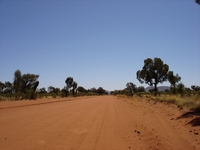
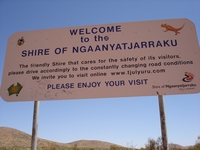
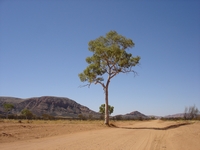
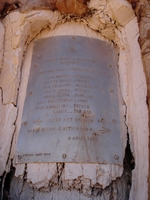
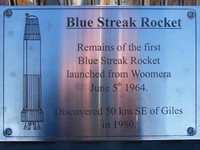

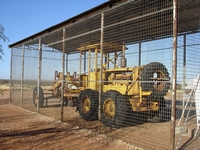
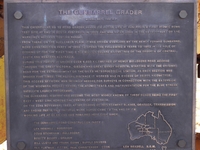
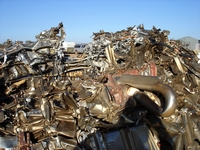
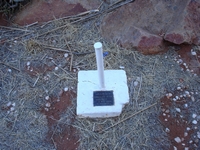
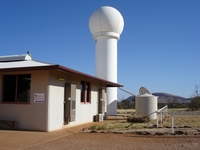
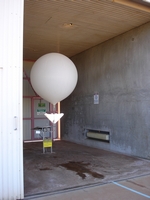
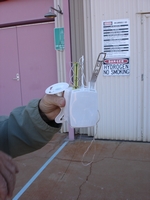
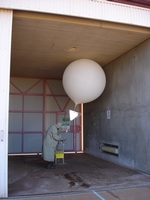
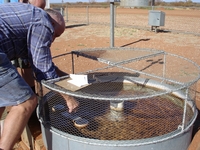
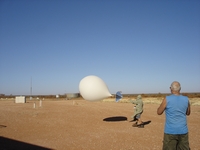
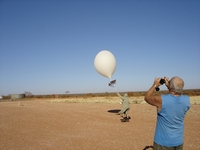
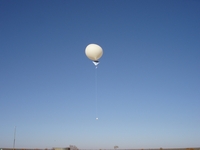
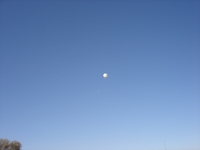
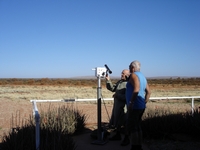
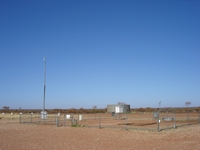
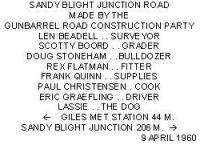
The balloon rises at 1,000 metres per second and goes to an altitude of approximately 35 kilometres before bursting.
Weather balloons are released from weather stations throughout the world at the simultaneously, giving a snapshot of the world's weather
twice a day. The balloon released in the afternoon is smaller than the morning balloon.
The station is staffed by a team of four who run it on a six-month tour. The station has satellite and telephone communications
facilities, and hydrogen gas is produced from water on site for weather balloons.
The original purpose of the station was to provide weather data for the UK atomic weapons tests at Emu Plains and Maralinga and to
support the rocket testing program based at Woomera. Giles Weather Station was transferred from the Department of Defence to
the Bureau of Meteorology in 1972.
The Giles Weather Station operates on South Australian time, so remember this when going to see the morning weather balloon release.
The station was established in 1956 by the Weapons Research Establishment (now known as the Defence Science and Technology Organisation),
a division of the Department of Defence.
The enclosure pictured at right contains the evaporation pond, thermometers and wind gauges. Wind at the taller on one the left
is twice the speed as at the shorter on to the right of the picture.
Other measurements taken include temperatures at ground level, half a metre and one metre below ground, minimum and maximum temperatures
over preceding 24 hours, evaporation over a 24 hour period, humidity and wind speed at two levels.
The balloon has a small transmitter dangling from it to transmit comprehensive weather data.
Update: Tours are no longer available, but the weather balloon releases can still be observed from the car park. See the
full details and times here.
Note that times given are on Central time (South Australian time).
Our overnight stop was at Warakurna where there was a pleasant camping area behind the roadhouse, as we had booked for the early morning
tour of the Giles Weather Station. Read the history of Giles Weather Station. Booking is not essential, but advisable:
telephone (08) 8956 7358. The visitor room at the weather station site contains weather and Len Beadell memorabilia.
Lasseterís Cave is a short drive in from the road.
The sign above left shows ranges with the name unusual name of Schwerin Mural Crescent. These ranges were discovered in
1875 by Ernest Giles and named after the Princess of Schwerin (a province which is now part of Germany). Gill pinnacle is towards
the north eat end of the crescent.
Prospector Harry Lasseter sheltered in this tiny cave alongside a dry Hull riverbed in 1931 for around 25 days. He was on an
expedition to try and re-discover his legendary rich gold reef and had quarrelled with his travelling companion and they had gone
separate ways, then his camels had bolted, leaving him stranded and ill with little water and no supplies of food.
He
buried his diary in this cave, which indicates how he understood he had a very poor chance of reaching his destination.
Copyright (C) 2013 AustraliaSoMuchtoSee.com. All rights reserved
Our Great Central Road tour continues on the next page
Follow the news on progressive sealing of the Outback Way, which incorporate the Great Central Road on our News Pages
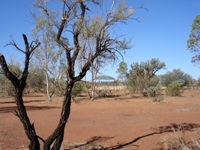
Since our visit, as rest area to park off the road has been provided at this tree, signed Gill Pinnacle Viewing Area. Gill pinnacle
can be seen in the lower left photo, behind the Schwerin Mural Crescent sign.
This is a replica sign, and the original can be seen in the visitor's room and the Giles Weather Station.






























